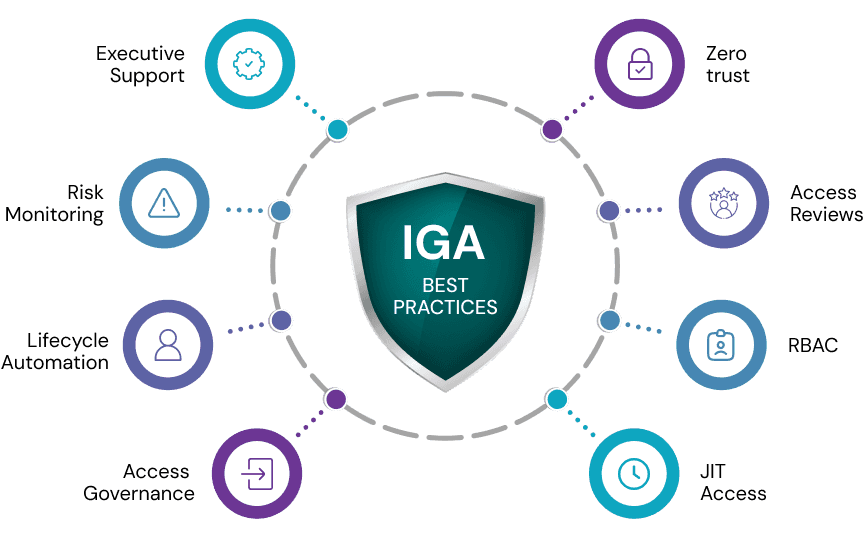
Best Practices for Identity Governance and Administration (IGA)


Let’s face it, today’s digital world has changed the rules of security. Identities have become the first line of defense, and unfortunately, they’re also a prime target. In fact, more than 25% of security breaches stem from web applications, with stolen credentials leading the charge.
This is where Identity Governance and Administration (IGA) becomes a game changer. It’s not just a back-office process or a compliance checkbox. Done right, IGA offers a structured yet flexible way to manage who has access to what and why across your entire organization.
But here's the catch: even the best IGA tools can fall short if not implemented thoughtfully. That’s why we’ve pulled together practical, field-tested best practices to help you move beyond the basics so your identity strategy is not only strong on paper but bulletproof in practice.
Key Takeaways:
- Identity and governance administration is crucial for managing access in today’s complex, high-risk business environment.
- Manual, error-prone access controls are the key concerns in the traditional IGA framework.
- IGA best practices, like zero trust and RBAC, strengthen security, reduce risk, and ensure policy-aligned access.
- An integrated and AI-powered IGA platform simplifies access management, ensures compliance, and unifies identity control across systems.
Why Best Practices in IGA Matter in 2025
Every organization is focusing on integrating all the platforms to create a centralized ecosystem. However, this increases the risk of cyber attacks and also makes it more challenging to manage user access. Many enterprises have an IGA framework in place, but implementing it with best practices is necessary to ensure that all the security and compliance policies are enforced properly.
Here’s how IGA best practices help enterprises:
- Rising Identity-Based Threats: Identity-related attacks like credential theft, privilege escalation, and insider misuse are increasingly common and sophisticated.
- Stricter Compliance and Audit Requirements: Regulations now demand tighter access controls, detailed audit trails, and real-time visibility into user permissions and entitlements.
- AI-Driven Governance at Scale: Automation and AI are reshaping identity governance, enabling faster access decisions, anomaly detection, and policy enforcement, but they require a solid framework to be effective.
- Risk of Tool Overload Without Strategy: Even the most advanced IGA tools can underperform without best practices guiding their implementation and usage.
Utilizing the IGA best practices today ensures your identity systems remain scalable, secure, and compliant as threats and technologies evolve.
7 Best Practices for Identity Governance and Administration

The identity access control best practices ensure appropriate access controls, detect malicious user behavior, protect sensitive data, and ensure compliance. So, let us have a look at seven essential identity governance and administration best practices to implement effective data access governance.
1. Executive Sponsorship & Governance Alignment
One of the IGA best practices is aligning executive stakeholders who will actively participate in the identity governance. Executives or leaders from IT, HR, legal, compliance, and senior management are usually a part of this process. Executive sponsorship ensures accountability and drives cross-functional collaboration, and helps align the IGA strategy with organizational goals and compliance requirements.
To support this alignment, it is important to first have a clear understanding of the organization’s objectives. It can be enhancing data security or meeting the industry-specific regulatory standards. It is necessary to know the specific regulatory frameworks that apply to your business. Then, you can effectively design the policies and processes for identity lifecycle management.
2. Adopt a Zero Trust Security Model
Zero trust is a security framework that is based on the principle of never trust, always verify. This means no device, user, or application should be inherently trusted. Every individual and device should be strictly verified and validated before giving access to the organization’s data, applications, or network.
Identity is one of the five core pillars of the zero-trust security framework. The others are network, devices, applications and workloads, and data.
To strengthen identity verification in zero trust, organizations should invest in identity and access management solutions (IAM), single sign-on (SSO), and multi-factor authentication. As IGA best practices, implement the least access privilege and role-based access controls.
- Least access privilege means that users and devices have access to only those applications and resources that are necessary to perform their duties.
- The role-based access control (RBAC) is a methodology that restricts system access on the basis of an employee’s role in the organization.
RBAC complements the principle of least privilege by providing a structured way to manage access rights at scale. With a centralized zero-trust system in place, you don’t need to hire as many people for managing, monitoring, securing, refining, and updating security controls.
3. Enforce Access Reviews & Recertifications
Periodic access reviews are essential to ensure that users still need the permissions they currently hold. Employees may leave the organization, change departments, or take on new responsibilities. In large enterprises, these changes can affect hundreds of user accounts.
Regular access reviews become a part of a broader cyber hygiene program. It helps in ensuring that permissions are accurate, appropriate, and aligned with current roles. With regular access reviews, organizations can remove excessive or outdated privileges, detect orphan accounts, revoke access for inactive users, and strengthen their overall security posture.
Additionally, access reviews are not just identity access control best practice; they are a compliance requirement under regulations such as Sarbanes-Oxley (SOX), PCI DSS, HIPAA, and GDPR. Failure to conduct them properly can expose the organization to legal and financial risks.
4. Implement Role-Based Access Control (RBAC)
Role-based access control, or RBAC, is an access management approach where minimum access provisions are assigned to employees on the basis of their job roles. This restricts access to only pre-defined role privileges.
It is one of the identity access control best practices as it eliminates the need to provision every user with a customized set of user permissions. RBAC defines every role and determines the access rights to each role. This makes it easier for organizations to onboard and offboard employees, update job functions, and transform business operations.
The RBAC system needs to follow three basic rules:
- Role assignment: Every user must assign at least one active role to exercise permissions and privileges.
- Role authorization: The user must be authorized to take the roles that are assigned.
- Permission authorization: Permissions or privileges are allowed only to the users who have been authorized through their role assignment.
An identity and access management solution can help in implementing both authorization and authentication required by RBAC. IAM systems can verify a user’s identity by checking their credentials in a centralized database. Then, after authentication, the system can check their role and grant the permissions as defined in the RBAC scheme.
5. Enable Just-in-Time (JIT) Access
Just-in-time access is another identity access control practice in which the users are provided temporary, time-bound access to specific systems, applications, or data, only when it’s needed and only for as long as necessary.
This is an IGA framework best practice as it helps in eliminating the risks associated with standing privileges. To implement Just-in-Time access, you first need to analyze the high-risk accounts or systems. This may include third-party contractor access, high-valued accounts (sysadmins, domain admins, etc), and DevOps.
You can deploy a privilege access management (PAM) solution that has JIT capabilities, like temporary privilege elevation and session-based access with automatic revocation. Now, JIT prioritizes how long the user has access to a certain resource. So, the shorter the time window, the better the security.
However, this shouldn't be applied as a rigid rule. Setting access durations too short may interrupt users before they can complete their tasks. The key is to balance security with productivity by defining time limits based on the nature of the task, risk level, and user role.
6. Automate Identity Lifecycle Management
Manually handling all the identity and access management processes becomes tedious and overwhelming as the business organization scales. Besides, the risk of errors and delays increases significantly, leading to security gaps, compliance issues, and poor user experience.
That’s why, as one of the identity governance best practices, automate the identity lifecycle management, from onboarding and access provisioning to role changes and off-boarding. This will streamline the process end-to-end, reduce administrative overhead, and ensure that all the requests related to identity access are resolved at the earliest.
With automation, users receive timely and appropriate access based on their current roles and responsibilities. It also ensures that access is revoked immediately when it's no longer needed, reducing the attack surface.
7. Monitor with Risk Analytics & Alerts
Continuous monitoring is the cornerstone for effective identity and access management. As an identity access control best practice, you need to shift from reactive to proactive identity governance strategy. By using risk analytics and real-time alerts, organizations can identify unusual behaviors, policy violations, or suspicious access patterns before they escalate into breaches.
IGA Solution Makes Best Practice Easy
Adopting an IGA platform isn’t just a one-time task. A robust IGA platform allows for defining, enforcing, and automating standardized processes across user provisioning, access reviews, policy management, and lifecycle automation. However, the best practices ensure that your organization uses the IGA platform to its maximum potential. It streamlines operations, reduces the risk of human error, eliminates unnecessary access, and improves audit readiness. Partner with Tech Prescient today, and make identity governance and administration a core pillar of your security.
Talk to our identity governance specialists and discover how Tech Prescient can transform your access management into a true pillar of security:
Frequently Asked Questions (FAQs)
- What is the most critical best practice in identity governance?
The most critical best practice is enforcing the principle of least privilege, ensuring users have only the access necessary to perform their roles. This minimizes risk exposure and limits the potential impact of insider threats or compromised accounts. - How often should I conduct access reviews?
Access reviews should be conducted at least quarterly, though highly regulated industries may require monthly or even real-time reviews. Frequency depends on risk level, regulatory requirements, and organizational complexity. - Can small businesses implement IGA best practices affordably?
Yes, small businesses can adopt IGA best practices using cloud-based solutions that offer scalable features, automation, and compliance tools without the high upfront costs of traditional enterprise systems. - What is the difference between IAM best practices and IGA best practices?
IAM (Identity and Access Management) best practices focus on managing user identities and access controls, like authentication and authorization. IGA framework best practices go further, adding oversight, compliance, role management, and access certification to ensure governance and reduce audit risk. - How does automation impact IGA best practices?
Automation enhances IGA by streamlining user provisioning, access reviews, policy enforcement, and audit reporting. It reduces human error, accelerates response times, and ensures consistent compliance across systems.